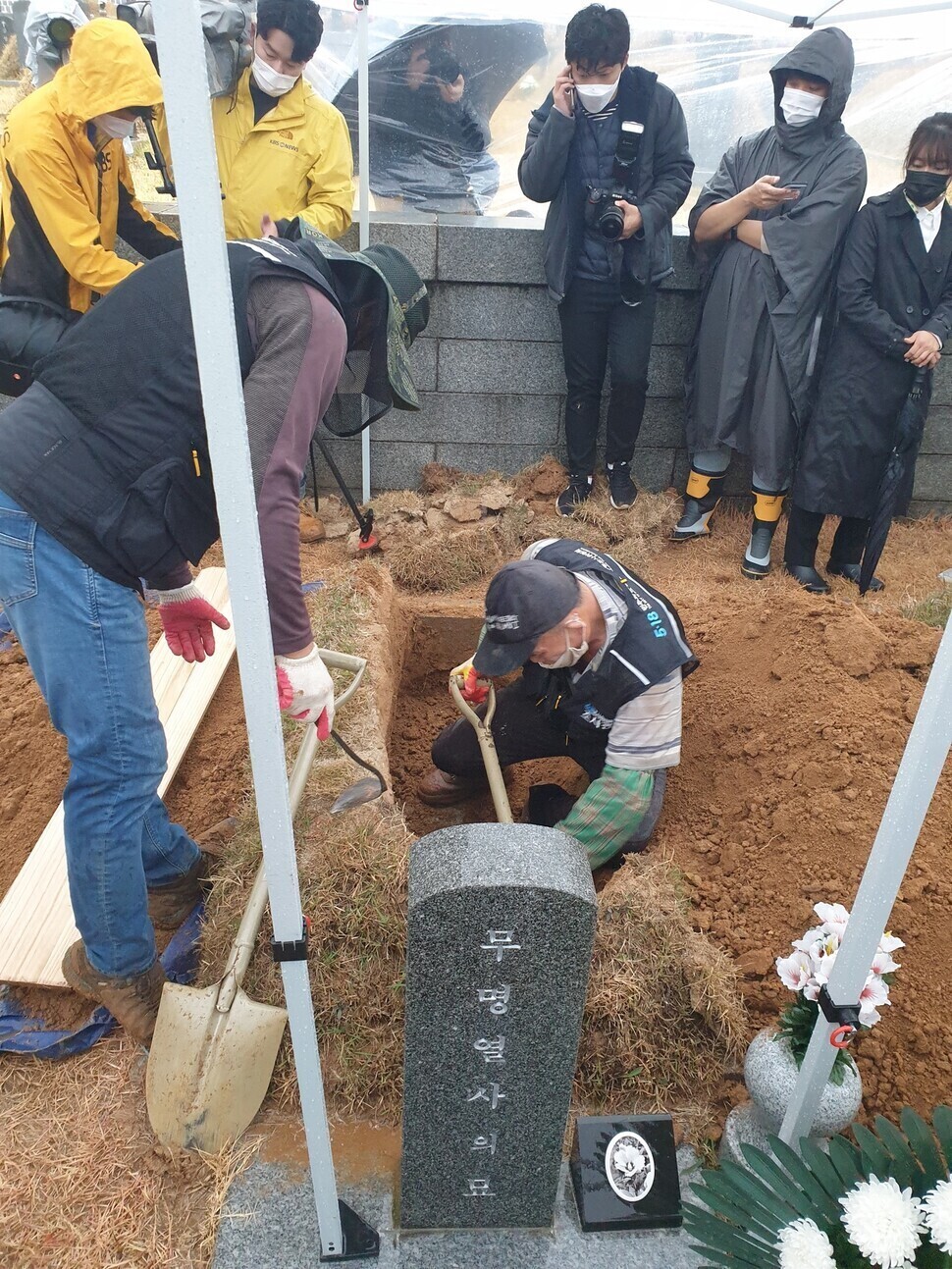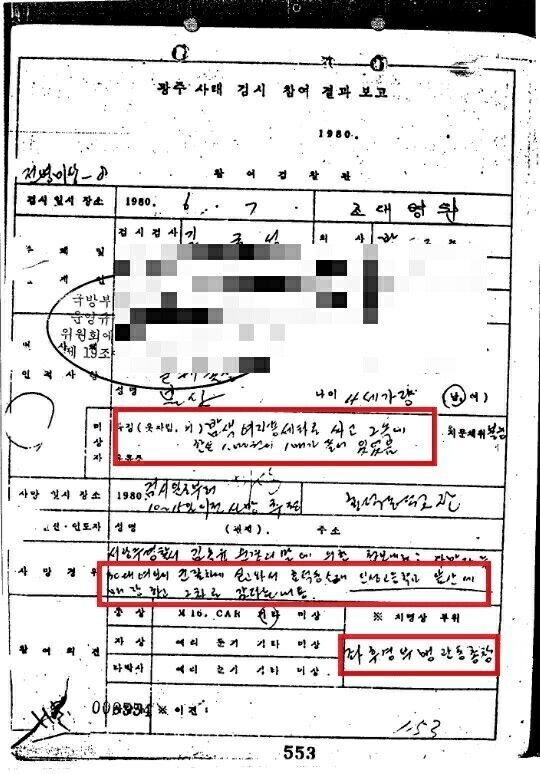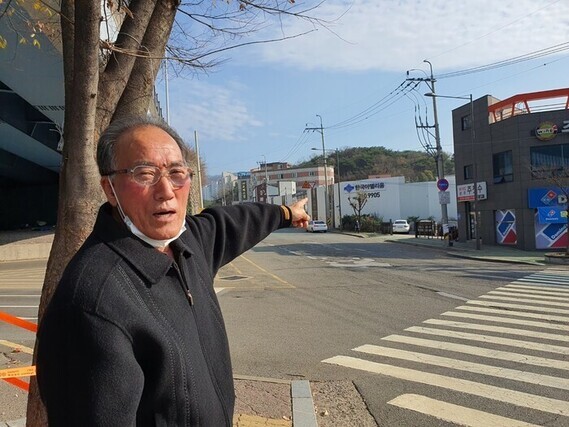hankyoreh
Links to other country sites 다른 나라 사이트 링크
[Reporter's notebook] Identifying 4-yr-old "unknown martyr" of Gwangju Uprising

At the Gwangju May 18 National Cemetery, there are five graves to the "unknown martyrs" (4-90, 4-92, 4-93, 4-96, and 4-97) and a grave for the missing — those whose bodies were never found (Area 10).
Most of the gravestones in the cemetery are inscribed with the name of the deceased, their date of birth and death, and the names of their family members. But the gravestones of the "unknown martyrs" only bear those two words, along with the date of burial. The grave for the missing feels especially sad because there are no bodies buried there.
Who are these unknown martyrs, and why couldn't their family members identify their bodies after they were killed? What happened to those who are missing? Might some of them still be alive?
There's been a lot of talk recently in Gwangju about a child buried in the "unknown martyrs" section of the May 18 National Cemetery. Someone has stepped forward who claims to know the identity of this child who was buried 41 years ago.
Grave 4-97 contains the body of a child, presumed to have been four years old at the time of death, whose family couldn't be found. The grave feels especially lonely because it's on the edge of the cemetery. The child's body was found in a shallow grave, in girl's clothing, on a hill in the Songam neighborhood of Gwangju's Nam (South) District, on June 9, 1980. The child was holding a 1,000 won bill (equivalent to about 4,600 won today, or US$4.07).

Cho Seong-gap, 78, who was working in the social services department of Gwangju City Hall at the time, was told about the child's body by an area resident. Cho then recovered the body and laid it to rest at the cemetery in Mangwol neighborhood, the former location of the May 18 National Cemetery.
According to autopsy records at Chosun University Hospital for that day, the child had died from a gunshot to the neck. The autopsy report stated that the child had died 10-15 days earlier, between May 23 and 28, 1980. The report also said that a woman in her 30s had brought the body in a jeep to a hill by Inseong High School in the Hyodeok neighborhood, buried the body there, and driven off. The mention of a jeep allows us to link the child's death to the military tentatively.
Lee Dong-chun, 62, a professor at Mokpo Science College who was arrested by government troops while defending the old South Jeolla Provincial Office on May 27, 1980, told the Hankyoreh that he believes he'd been with that mysterious child at the time of the militia's last stand at the provincial office.
Lee had hesitated to come forward until now because he didn't have any evidence. But then he came across video footage presumably shot by a foreign reporter on the morning of May 27, 1980, of himself in a military bus, holding a child.
In the footage, the child, wearing a red shirt, is staring out the window with apparent apprehension. The same scene can be seen in an exhibition of photos by foreign reporter Norman Thorpe currently running at the old South Jeolla Provincial Office from May 7-July 31.
"When the government troops stormed the provincial office, I was captured and taken to the square out front. Then a boy and girl in high school who were already in the square asked me to look after a young boy, who was four or five years old. We were bussed to the stockade at Sangmudae. While I was being processed, I handed the boy to a military policeman," Lee said.

Sangmudae was the headquarters for government troops sent to enforce martial law in North and South Jeolla Provinces.
Lee also related a story his younger sibling had heard from a military police officer who was stationed at Sangmudae around that time. The police officer told Lee's sibling that he remembered a child being brought to Sangmudae by one of the militia members. There was an uproar at the base when the child, who the soldiers had been looking after, suddenly vanished.
After the Hankyoreh ran this story, it received some tips about the mysterious child. One Gwangju resident in their 50s got in touch with the team in charge of restoring the old provincial office at the Ministry of Culture, Sports and Tourism. The citizen said the boy's face in the picture was very similar to the face of their younger brother, who had been wearing a red shirt during the uprising. The citizen added that their younger brother had been in the first grade of elementary school at the time but was very small and might have looked four or five years old.
The ministry's restoration team plans to run a DNA test on the child's remains in consultation with the May 18 Democratization Movement Truth Commission.
But the commission has a somewhat different opinion about the mysterious child since it has acquired testimony from soldiers who say they were the ones who killed and buried the child.

Three soldiers from the 62nd Battalion of the 11th Airborne Division, which was deployed to Gwangju during the uprising, said they'd been searching house to house for militia members in the Songam neighborhood on May 24, 1980, following an accidental exchange of fire with trainees at the infantry academy. During their search, they fired toward a play area and accidentally killed a child aged 4 or 5. When they found the dead child, they buried the body in a shallow grave.
The commission thinks this dead child may have been the one whose remains were recovered by Cho Seong-gap a few weeks later. But the testimony of the soldiers in the 62nd Battalion conflicts with the autopsy report's statement that the child was buried by a woman in her 30s, suggesting the need for further investigation.
A citizen surnamed Cho told the commission that they'd been on the military bus on May 27 and had been released along with a seven-year-old child three days later. That suggests that the boy who was with Lee might have still been alive on May 27.
It's still unclear what happened to the child who was with Lee, and the child's identity in the "unknown martyrs" section of the cemetery remains a mystery. The only ones who know for certain are the soldiers who were in Gwangju during the uprising.
By Kim Yong-hee, Gwangju correspondent
Please direct comments or questions to [english@hani.co.kr]

Editorial・opinion
![[Column] The state is back — but is it in business? [Column] The state is back — but is it in business?](https://flexible.img.hani.co.kr/flexible/normal/500/300/imgdb/original/2024/0506/8217149564092725.jpg) [Column] The state is back — but is it in business?
[Column] The state is back — but is it in business?![[Column] Life on our Trisolaris [Column] Life on our Trisolaris](https://flexible.img.hani.co.kr/flexible/normal/500/300/imgdb/original/2024/0505/4817148682278544.jpg) [Column] Life on our Trisolaris
[Column] Life on our Trisolaris- [Editorial] Penalties for airing allegations against Korea’s first lady endanger free press
- [Editorial] Yoon must halt procurement of SM-3 interceptor missiles
- [Guest essay] Maybe Korea’s rapid population decline is an opportunity, not a crisis
- [Column] Can Yoon steer diplomacy with Russia, China back on track?
- [Column] Season 2 of special prosecutor probe may be coming to Korea soon
- [Column] Park Geun-hye déjà vu in Yoon Suk-yeol
- [Editorial] New weight of N. Korea’s nuclear threats makes dialogue all the more urgent
- [Guest essay] The real reason Korea’s new right wants to dub Rhee a founding father
Most viewed articles
- 160% of young Koreans see no need to have kids after marriage
- 2[Column] Life on our Trisolaris
- 3New sex-ed guidelines forbid teaching about homosexuality
- 4Presidential office warns of veto in response to opposition passing special counsel probe act
- 5How daycares became the most viable business for the self-employed
- 6OECD upgrades Korea’s growth forecast from 2.2% to 2.6%
- 7Amid US-China clash, Korea must remember its failures in the 19th century, advises scholar
- 8Months and months of overdue wages are pushing migrant workers in Korea into debt
- 9[Column] The state is back — but is it in business?
- 10[Guest essay] Maybe Korea’s rapid population decline is an opportunity, not a crisis